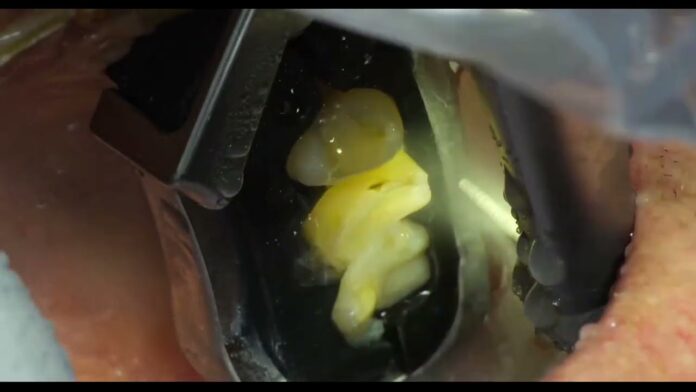Perceptive’s AI-driven robotic system successfully performs a groundbreaking dental procedure, promising greater speed and precision for future treatments
In a historic medical breakthrough, a robotic dentist has completed the first fully automated dental procedure on a human. The procedure was conducted using cutting-edge technology developed by Perceptive, a US-based leader in AI-driven dental automation.
The robotic system integrates a robotic arm with artificial intelligence and 3D imaging to perform intricate dental work, including fillings and crowns. This innovation aims to surpass traditional methods in both speed and accuracy, potentially revolutionizing the field of dentistry.
Dr. Chris Ciriello, CEO and founder of Perceptive, praised the achievement, stating, “This medical breakthrough enhances precision and efficiency in dental procedures.” The company, which has received $30 million (£23.5m) in funding, counts dentist Edward Zuckerberg, father of Meta CEO Mark Zuckerberg, among its backers.
One of the most promising aspects of Perceptive’s technology is its potential to drastically reduce the time required for common dental procedures. For example, crown placements, which traditionally require two separate hour-long visits to the dentist, could be completed in just 15 minutes using this robotic system.
The process begins with a 3D scan of the patient’s tooth and mouth, capturing detailed images even beneath the gum line. These images guide the robot in performing the procedure with high precision. However, despite this promising development, the technology is still in its early stages and is not yet available for sale in the United States. It also has not received clearance from the Food and Drug Administration (FDA).
Perceptive remains confident in the safety and transformative potential of their robotic dentist. As the technology continues to develop, it could lead to a future where dental procedures are faster, more accurate, and possibly more accessible.
Analysis
Technological: The successful completion of the world’s first fully automated dental procedure marks a significant technological milestone. The integration of AI and robotics in such a delicate field as dentistry showcases the advancements being made in medical technology. Perceptive’s system uses AI to analyze 3D scans and guide a robotic arm with extreme precision, reducing the likelihood of human error and potentially improving patient outcomes. As this technology matures, it could lead to more widespread adoption of robotics in other areas of healthcare, where precision and efficiency are critical.
Economic: Economically, the introduction of robotic dentistry could have a profound impact on the dental industry. By reducing the time required for procedures like crown placements, dental clinics could increase the number of patients they serve, potentially lowering costs and making dental care more accessible. However, the initial cost of implementing such advanced technology may be a barrier for smaller practices, potentially widening the gap between large, well-funded dental clinics and smaller, independent practices. Additionally, the shift toward automation may lead to changes in the workforce, with a reduced need for dental assistants or even dentists in certain routine procedures.
Social: Socially, the advent of robotic dentistry could change how patients perceive dental care. The promise of faster, more accurate procedures may alleviate common anxieties associated with dental visits, potentially increasing the number of people seeking regular dental care. However, there may also be resistance to the idea of a machine performing such intimate and critical tasks. Trust in technology will be crucial, and companies like Perceptive will need to ensure their systems are foolproof to gain widespread acceptance.
Regulatory: The lack of FDA clearance for Perceptive’s robotic system underscores the regulatory challenges that accompany such groundbreaking technology. As the FDA and other regulatory bodies assess the safety and efficacy of these systems, they will need to develop new frameworks for evaluating AI-driven medical devices. The regulatory process will play a critical role in determining how quickly this technology can be brought to market and integrated into standard dental practices. As more AI-driven medical technologies emerge, regulators will need to balance innovation with patient safety, setting precedents for future advancements.
Future Implications: Looking forward, the success of Perceptive’s robotic dentist could pave the way for further innovations in automated healthcare. As AI and robotics continue to advance, we may see a broader range of medical procedures becoming automated, from surgery to routine check-ups. This could lead to a healthcare system that is more efficient and accessible, but also one that requires significant changes in training for healthcare professionals. The role of doctors and dentists may shift from performing procedures to overseeing and programming robotic systems, requiring new skills and expertise.
